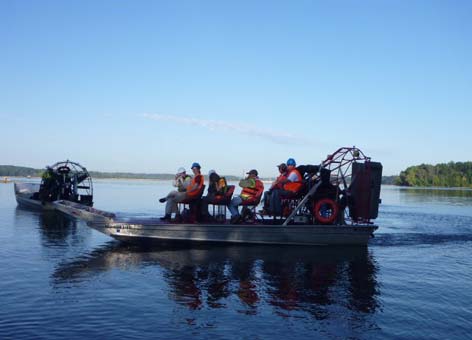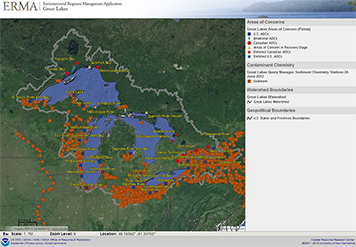With Eye Toward Restoring Ecosystems, NOAA Releases New Pollution Mapping Tool for Great Lakes
[Editor's Note: Happy Great Lakes Week! NOAA and our many U.S. and Canadian partners are celebrating and tackling issues for the world's largest source of liquid freshwater from September 9-12, 2013.]

SEPTEMBER 10, 2013 -- NOAA's Office of Response and Restoration is launching the Environmental Response Management Application (ERMA®) for the Great Lakes, an online mapping tool which will give decision makers, resource managers, and environmental responders better information as they clean up hazardous materials and restore the coastal and estuarine environments.
Great Lakes ERMA supports coastal pollution cleanup and restoration efforts across the Great Lakes Basin. This tool brings together regional data and information from NOAA and its partners into a single interactive map.
Great Lakes ERMA was created to help illustrate and expedite cleanup and restoration of Areas of Concern (areas identified by the U.S. and Canada as polluted and in need of cleanup and restoration). It does this by combining environmental contaminant data from NOAA's Great Lakes Query Manager database with ecological, recreational, tribal, and commercial information from across the region.
NOAA, as part of the Great Lakes Restoration Initiative, collaborated with the EPA, U.S. Coast Guard, and University of New Hampshire to develop Great Lakes ERMA. Out of the Great Lakes Restoration Initiative came a five-year action plan focusing on a handful of essential issues for the region, spanning the cleanup of toxic pollution (where Great Lakes ERMA comes in) to the combat of invasive species.
In addition to incorporating environmental cleanup and restoration information, OR&R has worked with emergency response colleagues within NOAA, EPA, Coast Guard, and the academic community on how to use ERMA in the Great Lakes to improve planning, communication, and coordination for responses to oil and chemical spills.

The History Behind the Data
A key part of Great Lakes ERMA is its connection to the data in the Query Manager database. In developing Great Lakes ERMA over the past year, OR&R Physical Scientist Ben Shorr had the opportunity to build upon that work done by NOAA scientists Jay Field and Todd Goeks. They established a Great Lakes–wide database with contaminant concentration data and the related impacts on living organisms.
This database, which is the product of close collaboration with the EPA Great Lakes National Program Office, the Army Corps of Engineers, and the Great Lakes states, is the region's most extensive compilation of environmental contaminant data. Comprised of data from smaller-scale watersheds and studies of individual pollution sites, the Great Lakes Query Manager database now contains over 480 studies with nearly 23,000 stations with contaminant chemistry results. By integrating this data into Great Lakes ERMA, accessing it for cleanup and environmental injury assessment and restoration at contaminant sites across the Great Lakes is now even easier.
A Data-rich Future
Looking to the future, the OR&R team that developed ERMA is excited about the opportunities to leverage NOAA and partner research and analysis in ERMA to highlight and further NOAA's mission of conserving and managing coastal and marine ecosystems and resources. This team continues working to build partnerships in the Great Lakes under the Great Lakes Restoration Initiative and on pollution cases and hazardous waste sites that are a focus for NOAA's Damage Assessment, Remediation, and Restoration Program.
Check out Great Lakes ERMA by visiting https://response.restoration.noaa.gov/great-lakes-erma.
